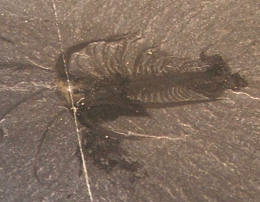Fossil of Marrella splendens (Marrellomorpha). Image: Wikipedia.
(PhysOrg.com) -- For hundreds of years, researchers from many branches of science have sought to explain the veritable explosion in diversity in animal organisms that started approximately 541 million years ago here on planet Earth. Known as the Cambrian period, it was the time, according to fossil evidence, when life evolved from simple one celled organisms, to creatures that had multiple cells with varied functions. Now, new evidence by a team of biologists, paleobiologists and ecologists suggests that the sudden explosion of new life forms may not have been so sudden after all. In their paper published in Science, the teams says that it appears likely that most of the new life forms that show up in fossil finds, were well on their way to development before the Cambrian period and that many of them, by their behaviors, may have helped pave the way for others.
To better understand what was happening before and during the Cambrian period, the team took a two-pronged approach: one side studied, compiled and updated the fossil evidence, while the other focused on the molecular makeup of various organisms to uncover their gene history to create a more precise family tree. By combining the evidence from both sides, the team was able to put together a picture of what they believe went on.
From their work it appears that the basic genetic components for the organisms that seemingly sprang into existence during the Cambrian period were in place long before the fossil records show. In fact, there appeared to be evidence of a slow march of development for 200 million years before the sudden diversity became evident, which indicates that many such organisms were slowly evolving and only showed when conditions became ripe.
The team suggests that for many of those 200 million years, Earth went through some very cold periods where the entire planet was likely frozen, stagnating development. Then, there came a time of warming, partly brought about, they theorize, by the development of organisms that were capable of changing the environment by pulling carbon from seawater and releasing more oxygen when they died and also by those that burrowed into the seafloor aerating it, providing a new type of environment for new types of organisms.
As more organisms developed, environmental conditions changed as a result, allowing for more diversity and so on and so forth through the Cambrian period, resulting in the explosion of all those new kinds of life forms that scientists have been puzzling over for years.
More information:
The Cambrian Conundrum: Early Divergence and Later Ecological Success in the Early History of Animals, Science 25 November 2011:
Vol. 334 no. 6059 pp. 1091-1097
DOI: 10.1126/science.1206375
ABSTRACT
Diverse bilaterian clades emerged apparently within a few million years during the early Cambrian, and various environmental, developmental, and ecological causes have been proposed to explain this abrupt appearance. A compilation of the patterns of fossil and molecular diversification, comparative developmental data, and information on ecological feeding strategies indicate that the major animal clades diverged many tens of millions of years before their first appearance in the fossil record, demonstrating a macroevolutionary lag between the establishment of their developmental toolkits during the Cryogenian [(850 to 635 million years ago (Ma)], and the later ecological success of metazoans during the Ediacaran (635 to 541 Ma) and Cambrian (541 to 488 Ma) periods. We argue that this diversification involved new forms of developmental regulation, as well as innovations in networks of ecological interaction within the context of permissive environmental circumstances.
Journal information: Science
© 2011 PhysOrg.com






















